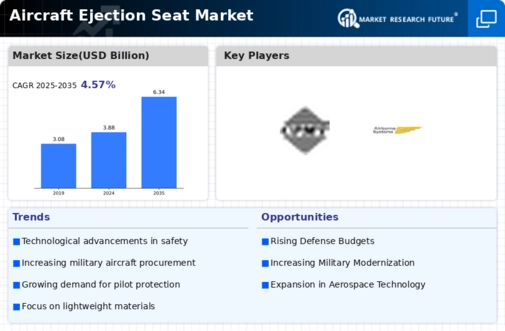Market Analysis
In-depth Analysis of Aircraft Ejection Seat Market Industry Landscape
Several market factors contribute to the dynamics of the Aircraft Ejection Seat market, reflecting the intricate balance between technological advancements, regulatory considerations, geopolitical influences, and the evolving needs of the aviation industry. One pivotal factor is technological innovation, with continuous advancements in materials, engineering, and safety systems driving the development of state-of-the-art ejection seats. The integration of cutting-edge technologies, such as smart sensors, lightweight materials, and advanced parachute systems, plays a crucial role in meeting the stringent safety requirements of modern aircraft.
Brace for liftoff and the reassuring rush of safety! The aircraft ejection seat market, valued at USD 3.5 billion in 2022, is preparing for a steady climb, reaching a projected USD 5.5 billion by 2032 with a 5.25% CAGR. This ascent is fueled by two crucial forces: a laser focus on pilot and crew safety through stricter regulations and the continuous development of cutting-edge ejection seats. So buckle up, knowing that in the face of unforeseen turbulence, these technological lifesavers are constantly evolving to give wings to hope. Regulatory compliance and safety standards are fundamental market factors shaping the Aircraft Ejection Seat sector. The aviation industry operates within a framework of strict safety regulations, and ejection seats must adhere to specific standards to ensure their efficacy in emergency scenarios. Compliance with these regulations not only enhances the safety of pilots but also influences the certification and acceptance of ejection seat systems by aviation authorities, playing a critical role in market access and growth.
Geopolitical factors and military modernization programs significantly impact the demand for Aircraft Ejection Seats. As nations invest in upgrading or replacing their air fleets, the need for advanced ejection seat technologies becomes imperative. Geopolitical tensions and security concerns drive military aviation programs, leading to increased procurement of cutting-edge ejection seats to ensure the safety of pilots in diverse operational environments. Global defense dynamics and security considerations contribute to the market factors influencing ejection seat demand.
The lifecycle of military aircraft, characterized by upgrades and retrofits, is a significant market factor. As older aircraft undergo modernization to extend their operational life or enhance their capabilities, the need for compatible ejection seat replacements or upgrades arises. Manufacturers that offer retrofit solutions, aligning with the evolving needs of aging aircraft, find opportunities in this market factor, providing cost-effective solutions for air forces seeking to enhance the safety of existing fleets.
Budget allocations for defense and aerospace programs influence market factors in the Aircraft Ejection Seat sector. The level of defense spending by nations determines the scale and pace of military modernization efforts, directly impacting the procurement of advanced ejection seat systems. Budget considerations and funding priorities within defense budgets play a crucial role in shaping the market, with manufacturers adapting to the budgetary constraints and requirements of military customers.
The emphasis on pilot training and simulation exercises is a market factor influencing ejection seat demand. Training programs often involve simulated ejection scenarios to prepare pilots for emergency situations. The incorporation of advanced simulation technologies that accurately replicate real-world ejection dynamics contributes to market growth. Manufacturers providing realistic and effective training solutions address the market factor of enhancing pilot proficiency and ensuring their preparedness for emergency ejection scenarios.
The commercial aviation sector's increasing focus on safety contributes to market factors in the Aircraft Ejection Seat market. While ejection seats are primarily associated with military aircraft, there is a growing trend in certain segments of the commercial aviation industry to explore safety enhancements, especially in high-performance civilian aircraft. The market factor of safety considerations in specific commercial aviation applications creates opportunities for manufacturers to contribute their expertise to broader aviation safety goals.
Human factors and ergonomic considerations represent a significant market factor in ejection seat design. With a diverse pilot demographic in air forces and aviation operations, manufacturers are focusing on designing ejection seats that accommodate various physical attributes and preferences. Customizable and adjustable features, along with considerations for pilot comfort and safety, are critical market factors ensuring that ejection seat systems effectively cater to the diverse needs of pilots.
The sustainability and environmental impact of ejection seat manufacturing are emerging market factors. Manufacturers are exploring eco-friendly materials and production processes to align with broader industry goals of reducing environmental impact. Sustainability considerations, including the life cycle of materials and recycling options, contribute to market factors influencing the industry's commitment to environmental responsibility.






Leave a Comment